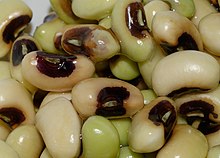| Black-eyed peas | |
|---|---|
 Fresh black-eyed peas | |
| Species | Vigna unguiculata (L.) Walp. |
| Cultivar group | Unguiculata |
| Cultivar | Black-eyed peas |
| Origin | West Africa[1] |
| Cultivar group members | lobia |
The black-eyed pea or black-eyed bean[2] is a legume grown around the world for its medium-sized, edible bean. It is a subspecies of the cowpea, an Old World plant domesticated in Africa, and is sometimes simply called a cowpea.
The common commercial variety is called the California Blackeye; it is pale-colored with a prominent black spot. The American South has countless varieties, many of them heirloom, that vary in size from the small lady peas to very large ones. The color of the eye may be black, brown, red, pink, or green. All the peas are green when freshly shelled and brown or buff when dried. A popular variation[3][4] of the black-eyed pea is the purple hull pea or mud-in-your-eye pea; it is usually green with a prominent purple or pink spot. The currently accepted botanical name for the black-eyed pea is Vigna unguiculata subsp. unguiculata,[5] although previously it was classified in the genus Phaseolus. Vigna unguiculata subsp. dekindtiana is the wild relative and Vigna unguiculata subsp. sesquipedalis is the related asparagus bean. Other beans of somewhat similar appearance, such as the frijol ojo de cabra (goat's-eye bean) of northern Mexico, are sometimes incorrectly called black-eyed peas, and vice versa.
- ^ "Tropical Forages: an interactive selection tool. Vigna ungiculata Factsheet". CSIRO Sustainable Ecosystems (CSIRO), Department of Primary Industries and Fisheries (DPI&F Queensland), Centro Internacional de Agricultura Tropical (CIAT) and International Livestock Research Institute (ILRI). June 2005. Archived from the original on 2010-12-14. Retrieved 2010-07-12.
- ^ West, Michael O. (2019-03-01), "Afterword Quilting the Black-Eyed Pea", To Turn the Whole World Over, University of Illinois Press, pp. 257–272, doi:10.5622/illinois/9780252042317.003.0013, ISBN 9780252042317, S2CID 204728150, retrieved 2022-03-31
- ^ "variation | Definition, Examples, & Facts | Britannica". www.britannica.com. Retrieved 2022-03-10.
- ^ Stephanie (2015-08-06). "Measures of Variation: Definition, Types and Examples". Statistics How To. Retrieved 2022-03-09.
- ^ "Showing Food Black-eyed pea - FooDB". foodb.ca. Retrieved 2021-09-17.